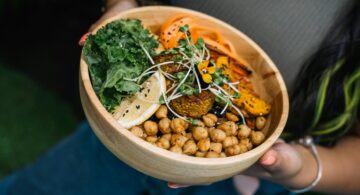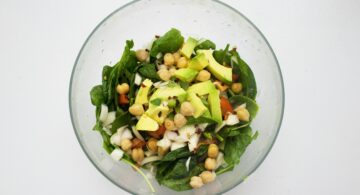For Your Eyes Only
Is It Really Possible to Improve Your Vision with Food?
Warning: blatant pop-culture references dead ahead…
When you think of improving vision with a certain food, which one darts into your mind faster than Bugs Bunny missing that left turn at “Alber-koiky?”
What’s up Doc?
Why it’s carrots, of course!
And what we aim to find out here today is if ole Bugs was on to something (other than annoying catch phrases) by eating carrots. If so, what other foods can and should be used to improve overall vision and help reduce the impact of dreaded eye diseases like glaucoma, cataracts, and macular degeneration.
But first, since ¾ of our country just doesn’t see so good – we’ll start with some interesting stats on corrective lenses.
Hey four eyes…over HERE!
The Vision Council of America says:
- About 75% of adults here in the U.S. use some sort of corrective lenses.
- 42% are men and 58% are women.
- Surprisingly, only 30% of these folks are near-sighted (myopia – needing glasses to see distance).
- Where 60% are far-sighted (hyperopia – needing glasses for up-close viewing).
Yes – you’re seeing that right. That adds up to only 90%…we’re not sure what happened to the other 10 – maybe they couldn’t see the question.
So if you were part of the group being teased for having “four eyes” in school, then…REJOICE! We were and still are part of the majority! Take THAT jock-guys and cheerleading prom-queens!
Still, for those of us who wear corrective lenses and would LOVE to put them on the nightstand – and LEAVE them there – the question remains: Do certain foods have the power to reverse myopia and hyperopia?
Fact is there is NO medical evidence that any one food or combination of foods can work to give you the ability to ditch the glasses.
However…if you want to hold on to the dream…have the patience to wait it out…and the stomach for it, many folks have reported that going vegan has improved their vision over time.
Also, there are simple eye exercises you can try that have offered some benefits to practitioners.
Eye yoga?
- Crazy 8s – Picture a large number “8” in front of you. Now, flip it on its side and slowly trace it with your eyes. Go in one direction for a few minutes then the other. Do this for as long as you can stand it each day and remember – 8 is enough!
- The Fonz – Extend your arm about a foot in front of you with your thumb in the Fonz’s “AYYYYY” position (remember the T-shirts?!). Next, focus on something much farther away and alternate between focusing on that and your thumb. Try this exercise of 2 minutes, rest and then repeat. This can strengthen your eye muscles over time and you can do it as much as you like – as long as it’s comfortable and you don’t get headaches . Your vision might be “correctamundo” in no time!
- Zoom, Zoom – Extend your arm full length out in front of you. Put your index finger out into the “we’re #1” position, then turn it so your finger’s profile is facing you. Focus on the tip of your finger and slowly bring it closer and closer to your eyes stopping at about an inch. Keep focusing and slowly re-extend your arm and repeat. You can perform this zoom, zoomin’ gem several times a day.
Finally, simply blink 5 times at one second per blink. Do this exercise for a couple minutes throughout the day.
If the above eye yoga moves work for you – great! If not, the foods we’ll cover here today are praised for their vision strengthening power and may also help protect your eyes from more serious conditions. So, stick with me here…
Because if you’re like most folks – you want to keep your eyes as healthy and peepin’ without creepin’ for as long as possible – corrective lenses or not.
So this month, your Home Cures That Work is all about vision health and special delicious foods that can help you maintain that sparkle in your eye for years to come. Get ready to raise your eye-Q.
Wearing glasses with stronger prescriptions is only a small part of what can dim your bright eyes
If only it were as simple as worrying about stronfger prescriptions and bifocals…
There are eye problems that can and do cause some serious health issues – even blindness. Often these conditions require surgery, which may or may not work on a permanent basis – if at all.
Here are some of those…and the natural foods that may prevent or reverse them:
Macular Degeneration (AMD)
AMD is a disease that affects the center of your field of vision in adults aged 50+. As it advances to its ultimate end – blindness – it can be very frustrating as you lose the ability to recognize faces and do something as simple as read – even large print. The macula is the center of the retina where the disease causes the most trouble. There are 2 forms – dry and wet. Dry is the most common where cells in the macula begin to break down and sensitivity to light is experienced before vision starts degrading. The wet form is more advanced and marked by new vessels in the macula leaking fluids. Where no one can be sure if patients with dry AMD will develop the wet, ALL patients with wet once had the dry form. The wet form can be treated with injections into the eyeball, or laser surgery but there are no guarantees for success. The dry form cannot be treated at all.
- Treatment: Exercise and the antioxidants of green leafy vegetables may help prevent it or slow it’s progression.
Keratoconus
This happens when the cornea assumes a conical shape protruding out of the center of the eye. It probably won’t cause you to go blind, but it can carry seriously debilitating vision problems. What causes it isn’t as clear as the symptoms, but the condition has been related to a body’s inability to properly metabolize what it takes in. Certain studies have shown a diet reduced in sugars helps.
- Treatment: Eating a plant-based diet with the freshest organic produce you can find can work to flatten the corneas. A grocery list of fresh fruits and veggies is coming up…
Glaucoma
This is a build up of pressure in the fluid of the optic nerve. When this pressure gets too high, it damages the nerve cells called rods and cones. This can cause tunnel vision, headaches, and peripheral vision reduction or loss.
- Treatment: Foods rich in vitamins A, C, and E can help enhance the overall health of your eyes so these should be carefully considered when establishing a new dietary, eye-healthy regimen.
- Zinc, lutein, and zeaxanthin are also excellent for eye health.
Cataracts
Cataracts can cause the pupil to turn milky-white. In most cases, the most common effect is ultra sensitivity to light since in a normal, healthy eye the pupil closes to block excess light. In patients with cataracts the pupil may not close enough or at all.
- Treatment: The American Optometric Association says that eating foods high in vitamin C may serve to prevent or reverse the progression of cataracts.
“Was blind but now I see…”
The biggest thing to natural eye health is – please forgive the pun – being able to “see” and not turn a blind eye to the benefits of delicious, nutritious foods that have been studied for their ability to help provide relief from advancing vision problems.
What has not been proven is the complete correction of certain vision problems. So, the following information should not be considered as a diagnosis or treatment of serious disorders of the eyes…
That said, as you age your vision can worsen by virtue of hormonal changes and pituitary gland production that can cause your eyes to change shape.
Through proper nutrition, you have the ability to address these hormonal changes and affect them to your favor.
Here is a grocery list for your eyes only. It contains foods with vitamins and nutrients that have been shown to be very beneficial in the health of your eyes and to combat hormonal changes that come with aging.
Even if you don’t feel your old enough to consider the effects of eye problems, I invite you to entertain the thought that working to prevent future issues is better than dealing with them as they begin to occur. I’m sure you’d agree…
With that in mind – let’s go shopping!
I only have eyes…for truth
Part one of our meal preparation begins with the fun of finding inexpensive yet powerful foods to bring healthy back.
So, here’s what we’ll need to get for excellent and natural eye health and why:
- Carrots – Carrots are packed with beta carotene, a nutrient that helps with the absorption of vitamin A, which resists damage to cells and tissues caused by oxidative stress. Though they’re not as exceptional in promoting eye health as thought in the past, they are still a healthy delicious snack – and that can’t hurt.
- Spinach, Kale – 2 antioxidants considered essential to high def vision are lutein and zeaxanthin and yep – these dark leafy guys got it – lots of it. So make sure they are often at the top of your shopping list. The American Optometric Association says they even act like “internal sunglasses” which can help “filter” [the sun’s] harmful blue rays.”
- Apricots – Are another nutritious food source of beta carotene…sweet delicious apricots add lycopene and together they work in concert to promote good eye health.
- Sweet Potatoes – High in vitamin C and A, sweet potatoes are a valuable source of antioxidant goodness for all cells and tissues – especially the eyes.
- Eggs – With omega-3 fatty acids and a good supply of eye-popping lutein, eggs may not have as much of the nutrient as the green leafies, but the secret is that your body absorbs lutein better through eggs.
- Wheat Germ – Vitamin E might serve to slow macular degeneration and may decrease the risk of cataracts. Wheat germ is our A-List source of this valuable nutrient.
Now you got it – what do you do with it?
Part 2 of our meal preparation phase is to understand what to do with this grocery list and how to use them with other vision-boosting ingredients.
So, on to the recipes…
Rainbow Spinach Omelet
What you’ll need:
- ½ cup chopped onion
- ½ cup chopped mushrooms
- ¼ cup chopped green pepper
- ¼ cup chopped red pepper
- A good handful of raw, organic spinach
- 1 egg
- 3 egg whites
What to do:
- Leaving all veggies raw yields the best results, but if you must – gently sauté the onion and peppers in water (sizzle) until the onions are translucent – add mushrooms and continue until the mushrooms are the desired consistency.
- Steam the spinach.
- Put veggies off to the side.
- Generously coat a skillet or – for best results – a non-stick, BPA-free pan with canola oil cooking spray.
- Beat the egg and egg whites in a bowl and pour in the pan.
- Just as the bottom of the omelet begins to bubble, pour in all veggies.
- Check bottom under veggies and gently fold omelet over and serve.
- If you’re using a non-stick, BPA-free pan, just gently shimmy the mixture over a serving plate until roughly half is on the plate and fold the rest over.
Fancy Carrot Salad
What you’ll need:
- 1 ½ cups finely chopped carrots
- ¼ cup golden raisins
- 2 tblsp wheat germ
- ¼ cup chopped, no-salt roasted walnuts
- ¼ cup sliced apricot
- ¼ cup canola oil
- 2 tblsp organic, apple cider vinegar (ACV)
- Pinch of cinnamon
- ½ tsp organic honey
What to do:
- Whisk oil, ACV, honey and cinnamon together until blended and set aside.
- Mix carrots, raisins, wheat germ, walnuts, and apricot in a bowl.
- Give the dressing another quick whisk and add to taste.
- Serve.
Salmon with Kale and Couscous
*Courtesy Ladies’ Home Journal
What you’ll need:
Couscous:
- 1 tablespoon olive oil
- 2 teaspoons finely chopped garlic
- 2 cups trimmed and coarsely chopped kale
- 1 cup water
- 1/2 teaspoon salt
- 3/4 cup couscous
- 1 tablespoon white wine
- 1 teaspoon butter or margarine
Salmon:
- 1 1/4 pounds center-cut salmon fillets
- 1 teaspoon olive oil
- 1/2 teaspoon salt
- 1/4 teaspoon freshly ground pepper
- Lemon wedges, optional
- Par-boiled sweet potatoes – diced
What to do:
- Make couscous: Heat oil in a 2-quart saucepan over medium heat; add garlic and cook 30 seconds. Add kale and stir; cover and cook 5 minutes, until kale is almost tender. Add water and salt to kale; bring to a boil. Stir in couscous; remove from heat and let stand 5 minutes. Stir in wine and butter.
- Cut salmon crosswise into 4 equal strips: Heat oil in a large skillet over medium-high heat. Sprinkle fish with salt and pepper; place in skillet skin side down. Cover and cook 6 to 8 minutes, just until cooked though.
- Divide couscous among 4 serving plates. Top each with a salmon fillet. Serve with lemon wedges and sweet potatoes.
Th-Th-That’s all folks!
“The moral of this story is don’t try to steal no eighteen carrots from no rabbit!” – Bugs Bunny
Some things to keep in mind as we close our vision-quest for natural eye health…
Are you “all in” on keeping yourself as healthy as possible by making simple dietary and lifestyle changes? Are you mindful of the benefits you will receive by making those changes? And do you truly believe that eating healthier foods with some moderate exercise will preserve and protect you for the rest of your life?
Good! That’s all you need to embrace! The rest will take care of itself…
Because all the nutritious foods discussed here today are rich in antioxidants and excellent vision-boosting properties – some have proven to work and others are only beginning to provide the benefits being studied.
And when it comes to your eyesight, you should be sure and check with your doctor if any condition worsens and you should also be sure and have your eyes examined every year.
Eating all the good foods we tell you about here in Home Cures That Work still has the power to help you with multiple conditions. So any way you slice it – you cannot go wrong.
Just like that wascally wabbit – you’ll always come out the victor…and have the last line in the show!






























